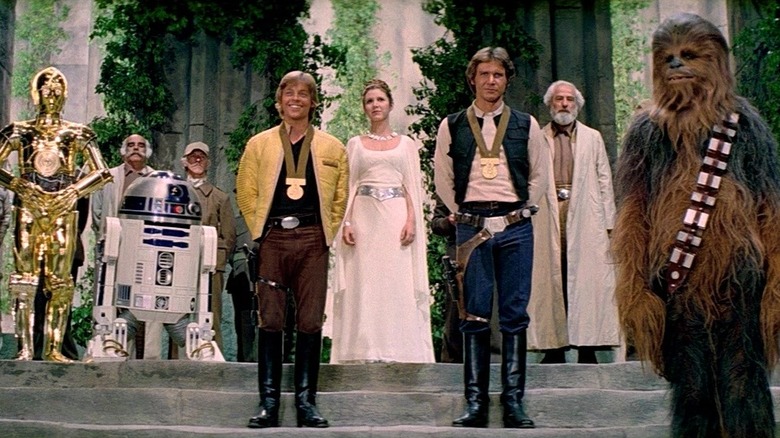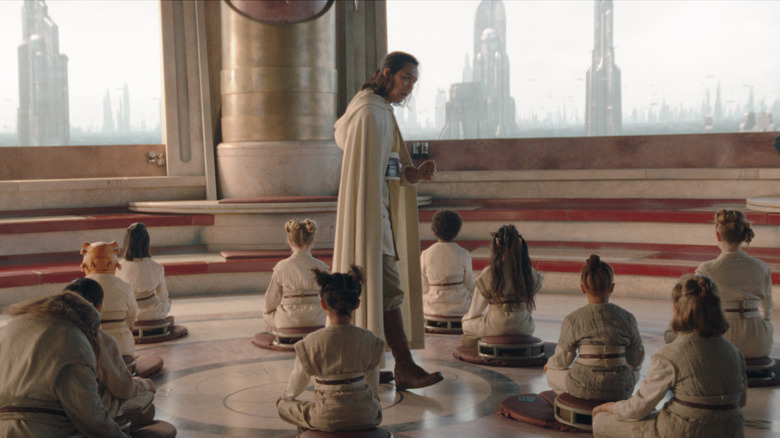
How do you measure a year in a life ... or, rather, a long time ago in a galaxy far, far away? For years, the mainline "Star Wars" films eschewed any formal in-universe calendar, instead simply referencing when events took place in relation to each other. There's 10 years between "Episode I -- The Phantom Menace" and "Episode II -- Attack of the Clones," for instance, and 19 years between "Episode III -- Revenge of the Sith" and "Episode IV -- A New Hope." In the background, however -- source books,
Expanded Universe stories, video games, etc. -- fans could find a much more formal timeline.
Over the years, especially since Disney acquired the franchise, that calendar system has worked its way more and more into the major "Star Wars" projects. "Andor," for instance, throws the year up on the screen on numerous occasions as the story marches toward the original trilogy: "5 BBY," "4 BBY," and so on. For those not in the know, "BBY" stands for "Before the Battle of Yavin." Its counterpart, "ABY," stands for "After the Battle of Yavin." As implied, these stand-ins for a BCE/CE or BC/AD calendar use the events of "A New Hope" -- specifically, the destruction of the first Death Star -- as the center point around which all other galactic events are dialed in.
For a long time, this calendar was only meant as a reference point for us in the real world, rather than an actual in-universe dating system. Again, though, that's changed in the Disney era. Indeed, there are a number of other calendars within the "Star Wars" lore, but none have caught on among fans in the same way as the BBY/ABY system.
Read more: Star Wars Movies Are Secretly Forbidden From Showing These Five Objects
Before And After The Battle Of Yavin

BBY and ABY were first introduced in West End Games' "Star Wars: The Roleplaying Game" in the mid-1990s. That was a time when the Expanded Universe, or Star Wars Legends as it's since been dubbed by Disney and Lucasfilm, was beginning to expand dramatically (no pun intended). Between Timothy Zahn's "Thrawn" or "Heir to the Empire" trilogy, the "Tales of the Jedi" (which explored the ancient origins of the Jedi and Sith), and other similar stories, the universe that was only loosely defined in George Lucas' original trilogy started to become a whole lot more detailed.
When you're drafting source books and reference materials for a tabletop roleplaying game, it helps to have a concrete calendar in mind. As Lucas had kept his own "Star Wars" timeline rather vague, the EU creatives of the day filled in the gaps. This, in turn, led to the BBY/ABY dating system catching on with fans and became a sort of standard, though there was always some confusion given the fractious nature of the EU.
Using "A New Hope" as the centerpiece of the calendar just seemed to make sense, though it has also meant there's a lot more "BBY" than "ABY" in the current canon. Disney has moved less than 50 years beyond the destruction of the first Death Star in its current "Star Wars" timeline, and though certain EU/Legends stories leapt forward several additional generations, that continuity still didn't go nearly as far into the future as it did into the past. The Old Republic era and times before it make up a huge portion of the calendar in both the pre and post-Disney canons, going back thousands of years.
Star Wars Has Many Other Calendars, But They Rarely Get Used

As I said before, the BBY/ABY calendar was originally meant as a reference point for fans, not characters in-universe. In fact, there are various other calendars referenced by characters in the current canon, including the Imperial Calendar, which uses the formation of the Empire as its central spoke, and the Coruscant Reckoning Calendar, which is referenced in "Andor." Separately, Disney has divided the timeline into distinct eras, like the High Republic, the Old Republic, The Reign of the Empire, and so on.
In a galaxy so big, it's natural that there would be many different ways of measuring a day, a year, or simply the cosmic span of time. That said, the BBY/ABY convention has entered the actual "Star Wars" universe more recently as well.
The 2024 book "The Rise and Fall of the Galactic Empire" by real-world author Chris Kempshall is presented as an in-universe history book attributed to fictional author Beaumont Kin. In that book, the character of Kin, a historian who served with the Resistance in the war against the First Order, argues for the adoption of the BBY/ABY calendar, as the destruction of the first Death Star, in his eyes, clearly divides the larger galaxy's history into two distinct eras. The book itself even acknowledges this move may be controversial, poking fun at some of the disagreements within the franchise and the fandom regarding official calendar systems.
If you're looking for the easiest way to keep up with all the major movie and TV news, why not sign up to our free newsletter?
Read the original article on SlashFilm.











